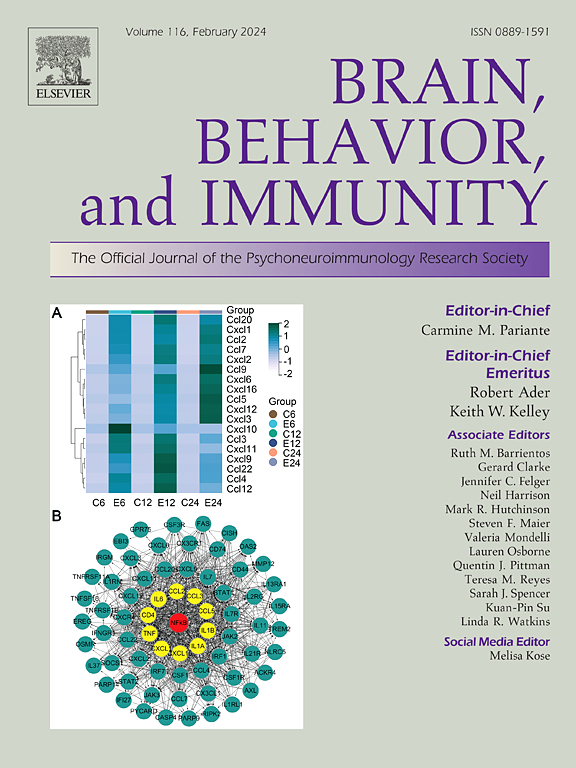情绪和焦虑症中的神经丝蛋白和胶质纤维酸性蛋白:系统综述和荟萃分析。
IF 8.8
2区 医学
Q1 IMMUNOLOGY
引用次数: 0
摘要
神经丝蛋白轻链(NfL)和胶质纤维酸性蛋白(GFAP)是脑脊液(CSF)和血液中可测量的神经元损伤生物标志物。尽管它们具有诊断神经退行性疾病的潜力,但它们在情绪和焦虑症中的表现尚不清楚。我们进行了一项系统综述和荟萃分析,以研究与健康对照组相比,NfL 和 GFAP 的浓度在患有情绪和焦虑症的成人中是否会发生改变。我们检索了截至 2024 年 8 月 20 日的 PubMed、Web of Science、PsycINFO、MEDLINE 和 Embase,并评估了相关研究及其偏倚风险。主要结果是NfL和GFAP浓度的标准化平均差(SMD)和95%置信区间(95% CI)。29 项研究共涉及 2,962 人(927 人患有重度抑郁症,804 人患有躁狂症,1,231 人患有对照组)。当我们比较重度抑郁症患者和健康对照组时,NfL 和 GFAP 水平没有差异。与对照组相比,双相情感障碍患者的 NfL 显著升高(SMD = 0.53;95 % CI:0.20,0.85;p = 0.005)。只有一项研究报告了焦虑症患者的 NfL 水平。我们的研究告诉临床医生如何解释这些新出现的生物标志物,以确定患者的症状是由神经退行性疾病还是情绪障碍引起的。双相情感障碍中 NfL 的轻度升高可能暗示着潜在的神经轴突损伤,值得进一步研究其临床和预后意义。本文章由计算机程序翻译,如有差异,请以英文原文为准。
Neurofilament light and glial fibrillary acidic protein in mood and anxiety disorders: A systematic review and meta-analysis
Neurofilament light chain (NfL) and glial fibrillary acidic protein (GFAP) are biomarkers of neuronal injury measurable in cerebrospinal fluid (CSF) and blood. Despite their potential as diagnostic tests for neurodegenerative disorders, it is unclear how they behave in mood and anxiety disorders. We conducted a systematic review and meta-analysis to investigate whether NfL and GFAP concentrations were altered in adults with mood and anxiety disorders compared to healthy controls. We searched PubMed, Web of Science, PsycINFO, MEDLINE and Embase through August 20, 2024, and assessed relevant studies and their risk of bias. The primary outcome was the standardised mean difference (SMD) and 95 % confidence interval (95 % CI) of NfL and GFAP concentrations. Twenty-nine studies comprising 2,962 individuals (927majordepression,804bipolardisorder,and1,231controls). When we compared individuals with major depression and healthy controls, there was no difference in NfL nor GFAP levels. In individuals with bipolar disorder, NfL was significantly elevated compared to controls (SMD = 0.53; 95 % CI: 0.20, 0.85; p = 0.005). Only one study reported on NfL levels anxiety disorders. Our study informs clinicians about how to interpret these emerging biomarkers in determining whether a person’s symptoms are caused by a neurodegenerative or mood disorder. The mild elevation of NfL in bipolar disorder may suggest underlying neuroaxonal injury, warranting further research into its clinical and prognostic significance.
求助全文
通过发布文献求助,成功后即可免费获取论文全文。
去求助
来源期刊
CiteScore
29.60
自引率
2.00%
发文量
290
审稿时长
28 days
期刊介绍:
Established in 1987, Brain, Behavior, and Immunity proudly serves as the official journal of the Psychoneuroimmunology Research Society (PNIRS). This pioneering journal is dedicated to publishing peer-reviewed basic, experimental, and clinical studies that explore the intricate interactions among behavioral, neural, endocrine, and immune systems in both humans and animals.
As an international and interdisciplinary platform, Brain, Behavior, and Immunity focuses on original research spanning neuroscience, immunology, integrative physiology, behavioral biology, psychiatry, psychology, and clinical medicine. The journal is inclusive of research conducted at various levels, including molecular, cellular, social, and whole organism perspectives. With a commitment to efficiency, the journal facilitates online submission and review, ensuring timely publication of experimental results. Manuscripts typically undergo peer review and are returned to authors within 30 days of submission. It's worth noting that Brain, Behavior, and Immunity, published eight times a year, does not impose submission fees or page charges, fostering an open and accessible platform for scientific discourse.

 求助内容:
求助内容: 应助结果提醒方式:
应助结果提醒方式:


